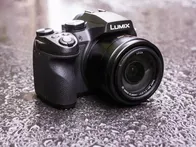Panasonic Lumix DMC-FZ300

When friends or family ask me if they should get a point-and-shoot or if their smartphone is good enough, my answer basically comes down to whether they need a camera with a superzoom lens or need one that is rugged. (Picture quality isn't really an issue anymore since the newest smartphones are on par with the average point-and-shoot. If you want better pictures, step up to a large-sensor advanced compact or a dSLR or mirrorless interchangeable lens camera.)
The Panasonic Lumix FZ300 is one of the only cameras available that can turn that "or" into an "and." Typically, if you want a rugged camera, one that can really handle drops and is waterproof, it won't have a very long zoom lens. The opposite is also true: If you want a lot of zoom, you're not going to find one that's extremely rugged. The FZ300, however, has a superb 24x f2.8 25-600mm lens and is also splashproof and dustproof.
The camera, which sells for about $500 in the US, AU$680 in Australia and £440 in the UK (where it's called the FZ330), also has such a full feature set that it's perfect if you want something in between a point-and-shoot and a digital SLR-like experience. Because it uses a 1/2.3-inch type sensor, though, (a size typically found in point-and-shoots and premium smartphones) its photo quality doesn't compare to a digital SLR or a large-sensor advanced compact, including Panasonic's own FZ1000. Losing some image quality is part of the price you pay to get the 35mm equivalent of an f2.8 600mm lens in a relatively compact and affordable package. A dSLR lens with those specs would be huge and cost thousands.
Just to clarify why this lens is so good, the problem with most superzoom cameras is that in order to keep the price and size of the camera small, the lenses have small apertures. Without getting too bogged down in specifics, a small aperture lets in less light, and less light can lead to motion blur and/or soft and noisy photos and movies. And when you zoom, the available maximum aperture gets even smaller letting in even less light.
The picture above is a good example of what I'm talking about. The JPEG's fine details have been smeared out of existence while the raw image I processed in about a minute with Adobe Camera Raw has much better detail if a little more noise. (You can see and download full-size versions of these photos and more in the gallery below.)
The camera's JPEGs could use some post-sharpening with editing software in general, but are certainly usable at smaller sizes at and above ISO 800, and the FZ300's Wi-Fi allows you to easily connect to an iOS or Android device and use Panasonic's app to transfer pictures and upload them to your choice of social networks for showing off to your followers. The app can also be used to fully control the camera remotely.